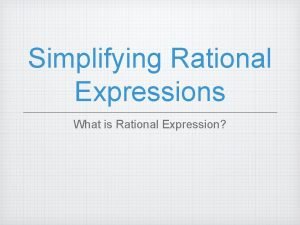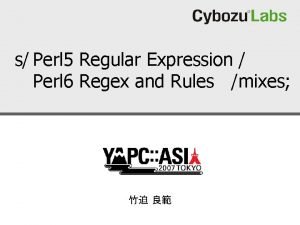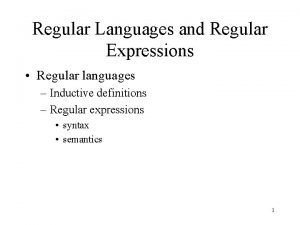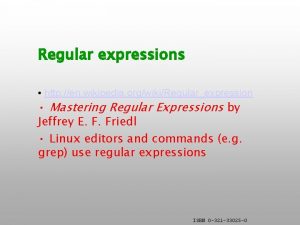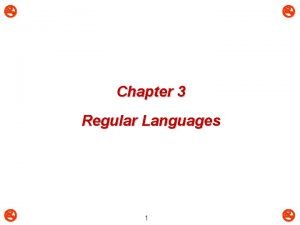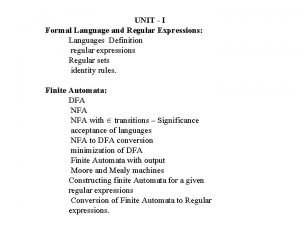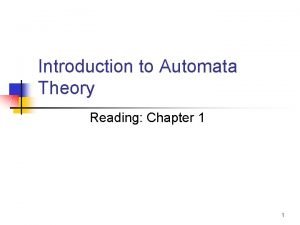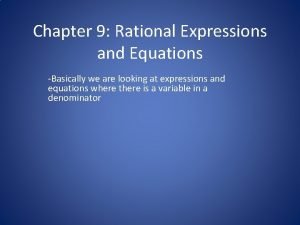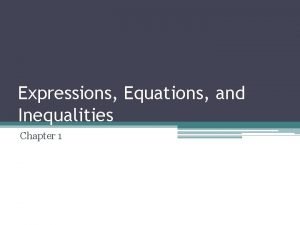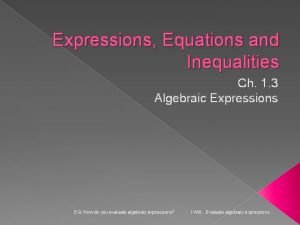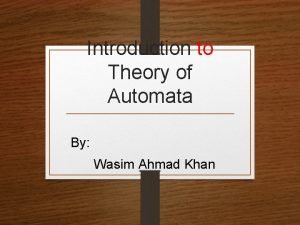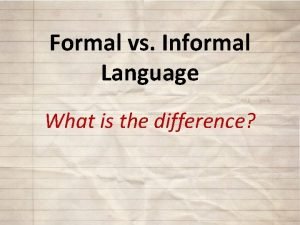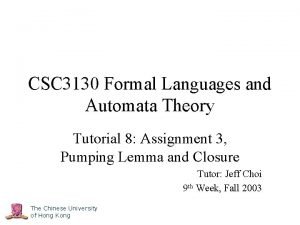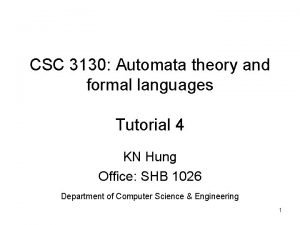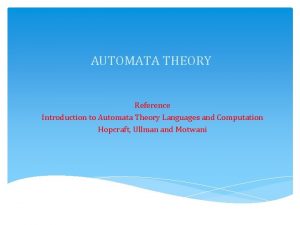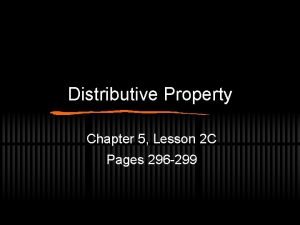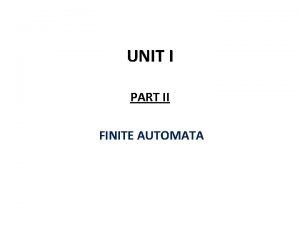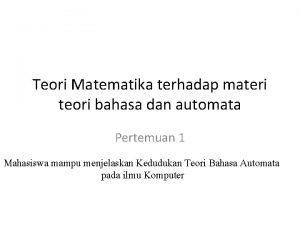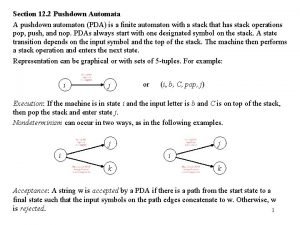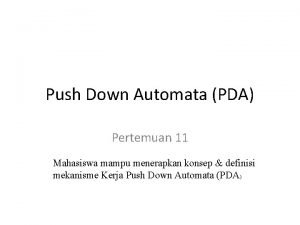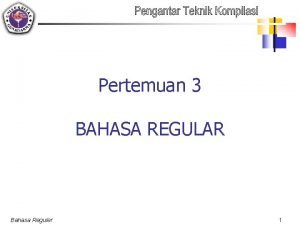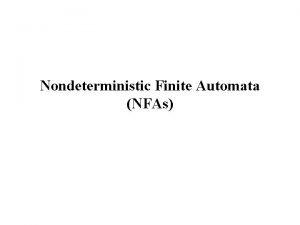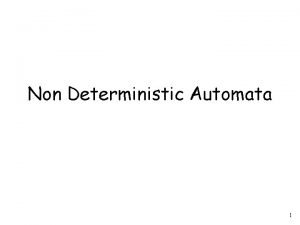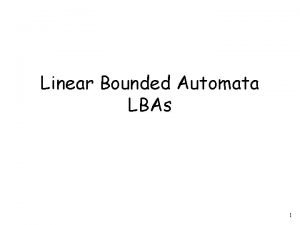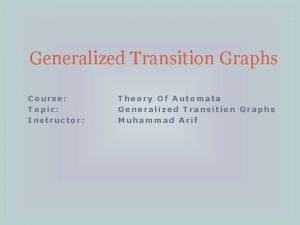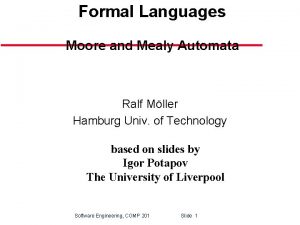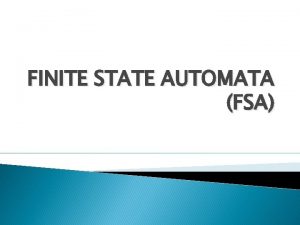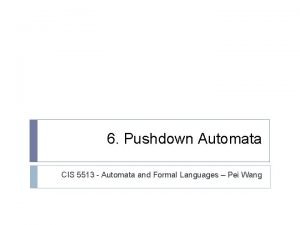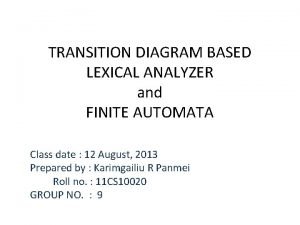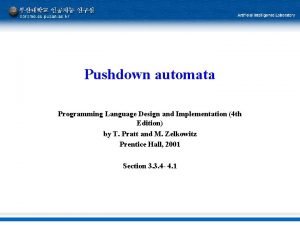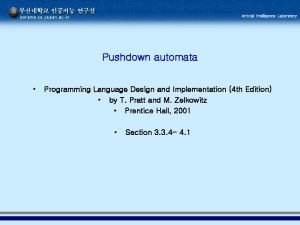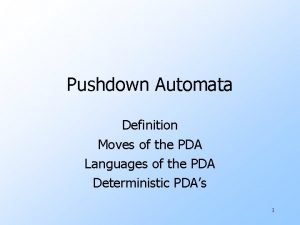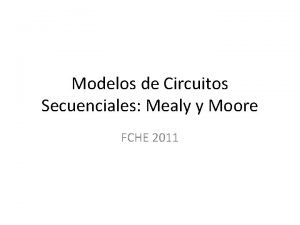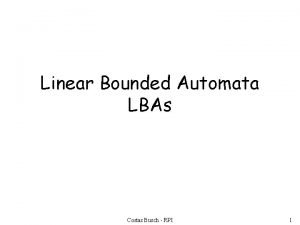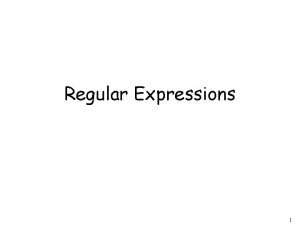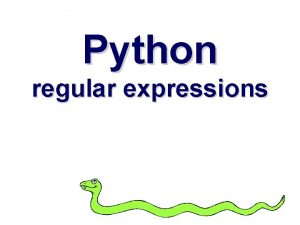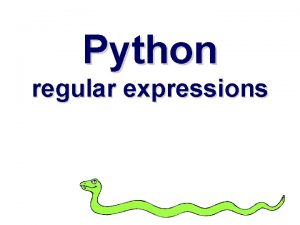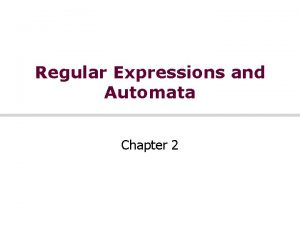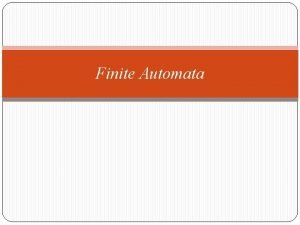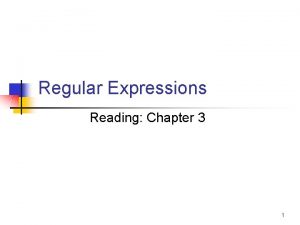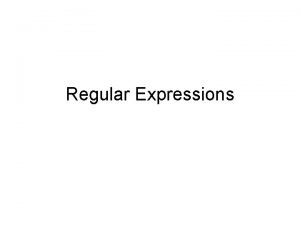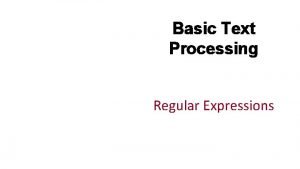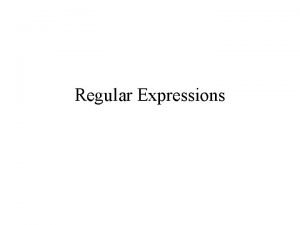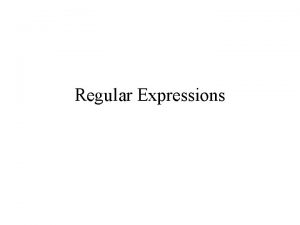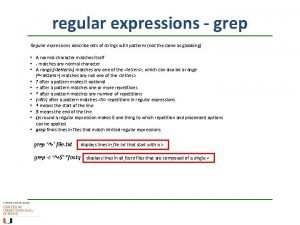CHAPTER 12 REGULAR EXPRESSIONS AND FINITESTATE AUTOMATA Copyright




























































- Slides: 60

CHAPTER 12 REGULAR EXPRESSIONS AND FINITE-STATE AUTOMATA Copyright © Cengage Learning. All rights reserved.

SECTION 12. 3 Simplifying Finite-State Automata Copyright © Cengage Learning. All rights reserved.

Simplifying Finite-State Automata Any string input to a finite-state automaton either sends the automaton to an accepting state or not, and the set of all strings accepted by an automaton is the language accepted by the automaton. It often happens that when an automaton is created to do a certain job (as in compiler construction, for example), the automaton that emerges “naturally” from the development process is unnecessarily complicated; that is, there may be an automaton with fewer states that accepts exactly the same language. 3

Simplifying Finite-State Automata It is desirable to find such an automaton because the memory space required to store an automaton with n states is approximately proportional to n 2. Thus approximately 10, 000 memory spaces are required to store an automaton with 100 states, whereas only about 100 memory spaces are needed to store an automaton with 10 states. 4

Simplifying Finite-State Automata In addition, the fewer states an automaton has, the easier it is to write a computer algorithm based on it; and to see that two automata both accept the same language, it is easiest to simplify each to a minimal number of states and compare the simplified automata. In this section we show to take a given automaton and simplify it in the sense of finding an automaton with fewer states that accepts the same language. 5

Example 1 – An Overview Consider the finite-state automata A and A in Figure 12. 3. 1. Two Equivalent Automata Figure 12. 3. 1 6

Example 1 – An Overview cont’d A moment’s thought should convince you that A accepts all those strings, and only those strings, that contain an even number of 1’s. But A, although it appears more complicated, accepts exactly those strings also. Thus the two automata are “equivalent” in the sense that they accept the same language, even though A has fewer states than A. Roughly speaking, the reason for the equivalence of these automata is that some of the states of A can be combined without affecting the acceptance or nonacceptance of any input string. 7

Example 1 – An Overview cont’d It turns out that s 2 can be combined with state s 0 and that s 3 can be combined with state s 1. The automaton with the two combined states {s 0, s 2} and {s 1, s 3} is called the quotient automaton of A and is denoted. Its transition diagram is obtained by combining the circles for s 0 and s 2 and for s 1 and s 3 and by replacing any arrow from a state s to a state t by an arrow from the combined state containing s to the combined state containing t. 8

Example 1 – An Overview cont’d For instance, since there is an arrow labeled 1 from s 1 to s 2 in A, there is an arrow labeled 1 from {s 1, s 3} to {s 0, s 2} in. The complete transition diagram for is shown in Figure 12. 3. 2. As you can see, except for labeling the names of the states, it is identical to the diagram for A. Figure 12. 3. 2 9

∗-Equivalence of States 10

∗-Equivalence of States Two states of a finite-state automaton are said to be ∗-equivalent (this is read “star equivalent”) if any string accepted by the automaton when it starts from one of the states is accepted by the automaton when it starts from the other state. We know that the value of the eventual-state function, N∗, for a state s and input string w is the state to which the automaton goes if the characters of w are input in sequence when the automaton is in state s. 11

∗-Equivalence of States In other words, states s and t are ∗-equivalent if, and only if, for all input strings w, 12

∗-Equivalence of States Or, more simply, for all input strings w, It follows immediately, by substitution into the definition, that 13

k-Equivalence of States 14

k-Equivalence of States From a procedural point of view, it is difficult to determine the ∗-equivalence of two states using the definition directly. According to the definition, you must know the action of the automaton starting in states s and t on all input strings in order to tell whether s and t are equivalent. But since most languages have infinitely many input strings, you cannot check individually the effect of every string that is input to an automaton. As a practical matter, you can tell whether or not two states s and t are ∗-equivalent by using an iterative procedure based on a simpler kind of equivalence of states called kequivalence. 15

k-Equivalence of States Two states are k-equivalent if any string of length less than or equal to k that is accepted by the automaton when it starts from one of the states is accepted by the automaton when it starts from the other state. 16

k-Equivalence of States Certain useful facts follow quickly from the definition of -equivalence: k The next theorem gives a recursive description of -equivalence of states. k 17

k-Equivalence of States It says, first, that any two states are 0 -equivalent if, and only if, either both are accepting states or both are nonaccepting states and, second, that any two states are k -equivalent (for k ≥ 1) if, and only if, they are (k − 1)-equivalent and for any input symbols their nextstates are also (k − 1)-equivalent. 18

k-Equivalence of States The truth of Theorem 12. 3. 1 follows from the fact that inputting a string w of length k has the same effect as inputting the first symbol of w and then the remaining k − 1 symbols of w. Theorem 12. 3. 1 implies that if you know which states are (k − 1)-equivalent (where k is a positive integer) and if you know the action of the next-state function, then you can figure out which states are k-equivalent. 19

k-Equivalence of States Specifically, if s and t are (k − 1)-equivalent states whose next-states are (k − 1)-equivalent for any input symbol m, then s and t are k-equivalent. Thus the k-equivalence classes are obtained by subdividing the (k − 1)-equivalence classes according to the action of the next-state function on the members of the classes. 20

Example 2 – Finding k-Equivalence Classes Find the 0 -equivalence classes, the 1 -equivalence classes, and the 2 -equivalence classes for the states of the automaton shown below. 21

Example 2 – Solution 1. 0 -equivalence classes: By Theorem 12. 3. 1 two states are 0 -equivalent if, and only if, both are accepting states or both are nonaccepting states. Thus there are two sets of 0 -equivalent states: and so 2. 1 -equivalence classes: By Theorem 12. 3. 1, two states are 1 -equivalent if, and only if, they are 0 -equivalent and, after input of any input symbol, their next-states are 0 -equivalent. 22

Example 2 – Solution cont’d Thus s 1 is not 1 -equivalent to s 0 because when a 0 is input to the automaton in state s 1 it goes to state s 2, whereas when a 0 is input to the automaton in state s 0 it goes to state s 0, and s 2 and s 0 are not 0 -equivalent. On the other hand, s 1 is 1 -equivalent to s 4 because when a 0 is input to the automaton in state s 1 or s 4 the next-states are s 2 and s 3, which are 0 -equivalent; and when a 1 is input to the automaton in state s 1 or s 4 the next-states are s 4 and s 1, which are 0 -equivalent. 23

Example 2 – Solution cont’d By a similar argument, s 2 is 1 -equivalent to s 3. Since 1 -equivalent states must also be 0 -equivalent [by property (12. 3. 4)], no other pairs of states can be 1 -equivalent. Hence 3. 2 -equivalence classes: By Theorem 12. 3. 1, two states are 2 -equivalent if, and only if, they are 1 -equivalent and, after input of any input symbol, their next-states are 1 -equivalent. 24

Example 2 – Solution cont’d Now s 1 is 2 -equivalent to s 4 because they are 1 -equivalent; and when a 1 is input to the automaton in state s 1 or s 4 the next-states are s 4 and s 1, which are 1 -equivalent; and when a 0 is input to the automaton in state s 1 or s 4 the next-states are s 2 and s 3, which are 1 -equivalent. Similarly, s 2 is 2 -equivalent to s 3. Since 2 -equivalent states must also be 1 -equivalent [by property (12. 3. 4)], no other pairs of states can be 2 -equivalent. 25

Example 2 – Solution cont’d Hence Note that the set of 2 -equivalence classes equals the set of 1 -equivalence classes. 26

Finding the ∗-Equivalence Classes 27

Finding the ∗-Equivalence Classes 28

Example 3 – Finding ∗-Equivalence Classes of R Let A be the finite-state automaton defined in Example 2. Find the ∗-equivalence classes of states of A. 29

Example 3 – Solution According to Example 2, the set of 1 -equivalence classes for A equals the set of 2 -equivalence classes. By Theorem 12. 3. 2, then, the set of ∗-equivalence classes also equals the set of 1 -equivalence classes. 30

Example 3 – Solution cont’d Hence By the notation of equivalence classes, ∗-equivalence classes of states of A are denoted as 31

The Quotient Automaton 32

The Quotient Automaton We next define the quotient automaton A of an automaton A. However, in order for all parts of the definition to make sense, we must point out two facts. The reason this is true is that the 0 -equivalence classes divide the set of states of A into accepting and nonaccepting states, and the ∗-equivalence classes are subsets of 0 -equivalence classes. 33

The Quotient Automaton This is true for the following reason. Suppose states s and t are ∗-equivalent. Then any input string that sends A to an accepting state when A is in state s sends A to an accepting state when A is in state t. Now suppose m is any input symbol, and consider the next-states N(s, m) and N(t, m). Inputting a string of length k to A when A is in state N(s, m) or N(t, m) produces the same effect as inputting a certain string of length k + 1 to A when A is in state s or t (namely the concatenation of m with the string of length k). 34

The Quotient Automaton Hence any string that sends A to an accepting state when A is in state N(s, m) also sends A to an accepting state when A is in state N(t, m). It follows that N(s, m) and N(t, m) are ∗-equivalent. Now we can define the quotient automaton A of A. 35

The Quotient Automaton It is the finite-state automaton whose states are the ∗ -equivalence classes of states of A, whose initial state is the ∗-equivalence class containing the initial state of A, whose accepting states are of the form [s] where s is an accepting state of A, whose input symbols are the same as the input symbols of A, and whose next-state function is derived from the next-state function for A in the following way: To find the next-state of A for a state s and an input symbol m, pick any state t in [s] and look to see what next-state A goes to if m is input when A is in state t; the equivalence class of this state is the next-state of A. 36

The Quotient Automaton 37

The Quotient Automaton Note that since the states of A are sets of states of A, A generally has fewer states than A. (A and A have the same number of states only in the case where each ∗ -equivalence class of states contains just one element. ) Also, by property (12. 3. 7), each accepting state of A consists entirely of accepting states of A. Furthermore, property (12. 3. 8) guarantees that the next-state function N is well defined. 38

Constructing the Quotient Automaton 39

Constructing the Quotient Automaton Let A be a finite-state automaton with set of states S, next-state function N, relation R∗ of ∗-equivalence of states, and relation Rk of k-equivalence of states. It follows from Theorems 12. 3. 2 and 12. 3. 3 and from the definition of quotient automaton that to find the quotient automaton A of A, you can proceed as follows: 1. Find the set of 0 -equivalence classes of S. 40

Constructing the Quotient Automaton 2. For each integer k ≥ 1, subdivide the (k − 1)-equivalence classes of S (as described earlier) to find the k -equivalence classes of S. Stop subdividing when you observe that for some integer K the set of (K + 1)-equivalence classes equals the set of K-equivalence classes. At this point, conclude that the set of K-equivalence classes equals the set of ∗-equivalence classes. 41

Constructing the Quotient Automaton 3. Construct the quotient automaton A whose states are the ∗-equivalence classes of states of A and whose next-state function N is given by where s is any state in [s]. [That is, to see where A goes if m is input to A when it is in state s, look to see where A goes if m is input to A when it is in state s. The ∗-equivalence class of that state is the answer. ] 42

Example 4 – Constructing a Quotient Automaton Consider the automaton A of Examples 2 and 3. This automaton is shown again below for reference. Find the quotient automaton of A. 43

Example 4 – Solution According to Example 3 the ∗-equivalence classes of the states of A are Hence the states of the quotient automaton A are The accepting states of A are s 2 and s 3, so the accepting state of A is [s 2] = [s 3]. 44

Example 4 – Solution cont’d The next-state function N of A is defined as follows: for all states [s] and input symbols m of A, Thus, But N(s 0, 0) = s 0, so 45

Example 4 – Solution cont’d Similarly, 46

Example 4 – Solution cont’d The transition diagram for A is, therefore, as shown below. By Theorem 12. 3. 3, this automaton accepts the same language as the original automaton. 47

Equivalent Automata 48

Equivalent Automata Output devices may be attached to the states of finite-state automata to indicate whether they are accepting or nonaccepting states. For example, accepting states might produce an output of 1 and nonaccepting states an output of 0. Then a finite-state automaton can be thought of as an input/output device whose input consists of strings and whose output consists of 0’s and 1’s. 49

Equivalent Automata We know that a circuit can be thought of as a black box that transforms combinations of input signals into output signals. Two circuits that produce identical output signals for each combination of input signals are called equivalent. Similarly, a finite-state automaton can be regarded as a black box that processes input strings and produces output signals (indicating whether or not the strings are accepted). 50

Equivalent Automata Two finite-state automata are called equivalent if they produce identical output signals for each input string. But this means that two finite-state automata are equivalent if, and only if, they accept the same language. 51

Example 5 – Showing That Two Automata Are Equivalent Show that the automata A and A that follow are equivalent. The label 0, 1 on an arrow of a transition diagram means that for either input 0 or 1, the next-state of the automaton is the state to which the arrow points. 52

Example 5 – Solution For the automaton A: The 0 -equivalence classes are The 1 -equivalence classes are The 2 -equivalence classes are 53

Example 5 – Solution cont’d This discussion shows that the set of 1 -equivalence classes equals the set of 2 -equivalence classes, so by Theorem 12. 3. 2 this is equal to the set of ∗-equivalence classes. Hence the ∗-equivalence classes are For the automaton A : By reasoning similar to that done previously, the 0 -equivalence classes are 54

Example 5 – Solution cont’d The 1 -equivalence classes are The 2 -equivalence classes are the same as the 1 - equivalence classes, which are therefore equal to the ∗equivalence classes. Thus the ∗-equivalence classes are 55

Example 5 – Solution cont’d To calculate the next-state functions for A and A , you repeatedly use the fact that in the quotient automaton, the next-state of [s] and m is the class of the next-state of s and m. For instance, and where N is the next-state function for A and N is the next-state function for A. 56

Example 5 – Solution cont’d The complete transition diagrams for the quotient automata A and A are shown below. 57

Example 5 – Solution cont’d As you can see, except for the labeling of the names of the states, A and A are identical and hence accept the same language. But by Theorem 12. 3. 3, each original automaton accepts the same language as its quotient automaton. Thus A and A accept the same language, and so they are equivalent. 58

Equivalent Automata In mathematics an object such as a finite-state automaton is called a structure. In general, when two mathematical structures are the same in all respects except for the labeling given to their elements, they are called isomorphic, which comes from the Greek words isos, meaning “same” or “equal, ” and morphe, meaning “from. ” 59

Equivalent Automata It can be shown that two automata are equivalent if, and only if, their quotient automata are isomorphic, provided that “inaccessible states” have first been removed. (Inaccessible states are those that cannot be reached by inputting any string of symbols to the automaton when it is in its initial state. ) 60
 Xkcd regex
Xkcd regex Site:slidetodoc.com
Site:slidetodoc.com Perl 5 regular expression
Perl 5 regular expression Inductive definition of regular expressions
Inductive definition of regular expressions Regular expressions wikipedia
Regular expressions wikipedia Regular expressions
Regular expressions Formal language
Formal language Primitive regular expressions
Primitive regular expressions Regular expressions
Regular expressions Which grammar generates regular language
Which grammar generates regular language Automata chapter 1
Automata chapter 1 Chapter 9 rational expressions and equations answers
Chapter 9 rational expressions and equations answers Chapter 1 expressions equations and inequalities
Chapter 1 expressions equations and inequalities Chapter 1 expressions equations and inequalities
Chapter 1 expressions equations and inequalities Language
Language What is the concept of valid and invalid alphabets
What is the concept of valid and invalid alphabets Informal language characteristics
Informal language characteristics Csci 3130
Csci 3130 Formal languages and automata theory tutorial
Formal languages and automata theory tutorial Formal languages and automata theory tutorial
Formal languages and automata theory tutorial Gtg stands for in automata
Gtg stands for in automata Cyk algorithm
Cyk algorithm Formal languages and automata theory tutorial
Formal languages and automata theory tutorial Basic concepts of automata theory
Basic concepts of automata theory Tujuan dari reduksi jumlah state pada dfa
Tujuan dari reduksi jumlah state pada dfa Cis262
Cis262 9(3+c+4) distributive property
9(3+c+4) distributive property Moore machine
Moore machine Two stack pda
Two stack pda Ekspresi reguler adalah
Ekspresi reguler adalah Grammar math
Grammar math Contoh soal dan jawaban aturan produksi fsa
Contoh soal dan jawaban aturan produksi fsa Sebutkan level 0 dari fsa (natural language) ?
Sebutkan level 0 dari fsa (natural language) ? String matching finite automata
String matching finite automata Pushdown automata
Pushdown automata What is recursive language
What is recursive language Contoh push down automata
Contoh push down automata Contoh soal dan jawaban push down automata
Contoh soal dan jawaban push down automata Expressions grammar
Expressions grammar Non deterministic finite automata
Non deterministic finite automata Nfa
Nfa Linear bounded automata is
Linear bounded automata is Invatare automata
Invatare automata Tg in automata
Tg in automata Mealy machine state diagram
Mealy machine state diagram Npda automata
Npda automata Simple grammar automata
Simple grammar automata Contoh fsa
Contoh fsa Felina hungária kft
Felina hungária kft Automata etimologia
Automata etimologia Automata
Automata Lexical analysis finite automata
Lexical analysis finite automata Transition graph in automata
Transition graph in automata Bidirectional transducers in automata theory
Bidirectional transducers in automata theory Pushdown automata implementation
Pushdown automata implementation Pushdown automata implementation
Pushdown automata implementation Xxxz0
Xxxz0 Contoh soal ekspresi reguler automata
Contoh soal ekspresi reguler automata Automata de mealy y moore
Automata de mealy y moore Cellular automata matlab
Cellular automata matlab Linear bounded automata
Linear bounded automata

